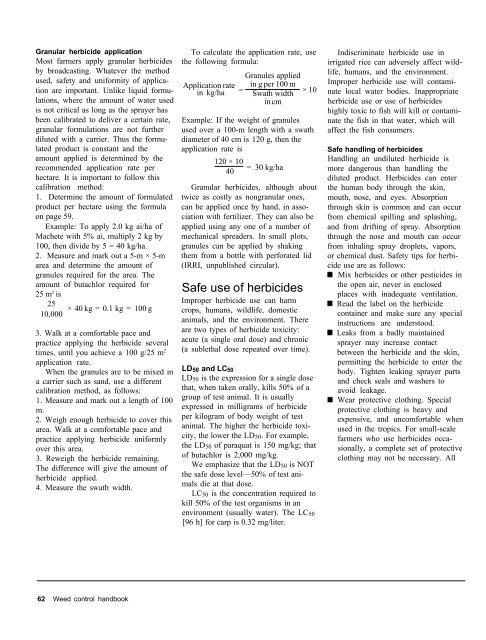A handbbok on Weed Control in Rice.pdf
A handbbok on Weed Control in Rice.pdf
A handbbok on Weed Control in Rice.pdf
Create successful ePaper yourself
Turn your PDF publications into a flip-book with our unique Google optimized e-Paper software.
Granular herbicide applicati<strong>on</strong><br />
Most farmers apply granular herbicides<br />
by broadcast<strong>in</strong>g. Whatever the method<br />
used, safety and uniformity of applicati<strong>on</strong><br />
are important. Unlike liquid formulati<strong>on</strong>s,<br />
where the amount of water used<br />
is not critical as l<strong>on</strong>g as the sprayer has<br />
been calibrated to deliver a certa<strong>in</strong> rate,<br />
granular formulati<strong>on</strong>s are not further<br />
diluted with a carrier. Thus the formulated<br />
product is c<strong>on</strong>stant and the<br />
amount applied is determ<strong>in</strong>ed by the<br />
recommended applicati<strong>on</strong> rate per<br />
hectare. It is important to follow this<br />
calibrati<strong>on</strong> method:<br />
1. Determ<strong>in</strong>e the amount of formulated<br />
product per hectare us<strong>in</strong>g the formula<br />
<strong>on</strong> page 59.<br />
Example: To apply 2.0 kg ai/ha of<br />
Machete with 5% ai, multiply 2 kg by<br />
100, then divide by 5 = 40 kg/ha.<br />
2. Measure and mark out a 5-m × 5-m<br />
area and determ<strong>in</strong>e the amount of<br />
granules required for the area. The<br />
amount of butachlor required for<br />
25 m2 is<br />
25<br />
× 40 kg = 0.1 kg = 100 g<br />
10,000<br />
3. Walk at a comfortable pace and<br />
practice apply<strong>in</strong>g the herbicide several<br />
times, until you achieve a 100 g/25 m2 applicati<strong>on</strong> rate.<br />
When the granules are to be mixed <strong>in</strong><br />
a carrier such as sand, use a different<br />
calibrati<strong>on</strong> method, as follows:<br />
1. Measure and mark out a length of 100<br />
m.<br />
2. Weigh enough herbicide to cover this<br />
area. Walk at a comfortable pace and<br />
practice apply<strong>in</strong>g herbicide uniformly<br />
over this area.<br />
3. Reweigh the herbicide rema<strong>in</strong><strong>in</strong>g.<br />
The difference will give the amount of<br />
herbicide applied.<br />
4. Measure the swath width.<br />
62 <strong>Weed</strong> c<strong>on</strong>trol handbook<br />
To calculate the applicati<strong>on</strong> rate, use<br />
the follow<strong>in</strong>g formula:<br />
Granules applied<br />
Applicati<strong>on</strong> rate<br />
<strong>in</strong> kg/ha =<br />
<strong>in</strong> g per 100 m<br />
Swath width<br />
<strong>in</strong> cm<br />
× 10<br />
Example: If the weight of granules<br />
used over a 100-m length with a swath<br />
diameter of 40 cm is 120 g, then the<br />
applicati<strong>on</strong> rate is<br />
120 × 10<br />
40<br />
= 30 kg/ha<br />
Granular herbicides, although about<br />
twice as costly as n<strong>on</strong>granular <strong>on</strong>es,<br />
can be applied <strong>on</strong>ce by hand, <strong>in</strong> asso-<br />
ciati<strong>on</strong> with fertilizer. They can also be<br />
applied us<strong>in</strong>g any <strong>on</strong>e of a number of<br />
mechanical spreaders. In small plots,<br />
granules can be applied by shak<strong>in</strong>g<br />
them from a bottle with perforated lid<br />
(IRRI, unpublished circular).<br />
Safe use of herbicides<br />
Improper herbicide use can harm<br />
crops, humans, wildlife, domestic<br />
animals, and the envir<strong>on</strong>ment. There<br />
are two types of herbicide toxicity:<br />
acute (a s<strong>in</strong>gle oral dose) and chr<strong>on</strong>ic<br />
(a sublethal dose repeated over time).<br />
LD 50 and LC 50<br />
LD 50 is the expressi<strong>on</strong> for a s<strong>in</strong>gle dose<br />
that, when taken orally, kills 50% of a<br />
group of test animal. It is usually<br />
expressed <strong>in</strong> milligrams of herbicide<br />
per kilogram of body weight of test<br />
animal. The higher the herbicide toxi-<br />
city, the lower the LD 50 . For example,<br />
the LD 50 of paraquat is 150 mg/kg; that<br />
of butachlor is 2,000 mg/kg.<br />
We emphasize that the LD 50 is NOT<br />
the safe dose level—50% of test ani-<br />
mals die at that dose.<br />
LC 50 is the c<strong>on</strong>centrati<strong>on</strong> required to<br />
kill 50% of the test organisms <strong>in</strong> an<br />
envir<strong>on</strong>ment (usually water). The LC 50<br />
[96 h] for carp is 0.32 mg/liter.<br />
Indiscrim<strong>in</strong>ate herbicide use <strong>in</strong><br />
irrigated rice can adversely affect wild-<br />
life, humans, and the envir<strong>on</strong>ment.<br />
Improper herbicide use will c<strong>on</strong>tami-<br />
nate local water bodies. Inappropriate<br />
herbicide use or use of herbicides<br />
highly toxic to fish will kill or c<strong>on</strong>tami-<br />
nate the fish <strong>in</strong> that water, which will<br />
affect the fish c<strong>on</strong>sumers.<br />
Safe handl<strong>in</strong>g of herbicides<br />
Handl<strong>in</strong>g an undiluted herbicide is<br />
more dangerous than handl<strong>in</strong>g the<br />
diluted product. Herbicides can enter<br />
the human body through the sk<strong>in</strong>,<br />
mouth, nose, and eyes. Absorpti<strong>on</strong><br />
through sk<strong>in</strong> is comm<strong>on</strong> and can occur<br />
from chemical spill<strong>in</strong>g and splash<strong>in</strong>g,<br />
and from drift<strong>in</strong>g of spray. Absorpti<strong>on</strong><br />
through the nose and mouth can occur<br />
from <strong>in</strong>hal<strong>in</strong>g spray droplets, vapors,<br />
or chemical dust. Safety tips for herbi-<br />
cide use are as follows:<br />
Mix herbicides or other pesticides <strong>in</strong><br />
the open air, never <strong>in</strong> enclosed<br />
places with <strong>in</strong>adequate ventilati<strong>on</strong>.<br />
Read the label <strong>on</strong> the herbicide<br />
c<strong>on</strong>ta<strong>in</strong>er and make sure any special<br />
<strong>in</strong>structi<strong>on</strong>s are understood.<br />
Leaks from a badly ma<strong>in</strong>ta<strong>in</strong>ed<br />
sprayer may <strong>in</strong>crease c<strong>on</strong>tact<br />
between the herbicide and the sk<strong>in</strong>,<br />
permitt<strong>in</strong>g the herbicide to enter the<br />
body. Tighten leak<strong>in</strong>g sprayer parts<br />
and check seals and washers to<br />
avoid leakage.<br />
Wear protective cloth<strong>in</strong>g. Special<br />
protective cloth<strong>in</strong>g is heavy and<br />
expensive, and uncomfortable when<br />
used <strong>in</strong> the tropics. For small-scale<br />
farmers who use herbicides occa-<br />
si<strong>on</strong>ally, a complete set of protective<br />
cloth<strong>in</strong>g may not be necessary. All











